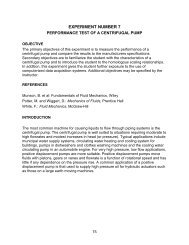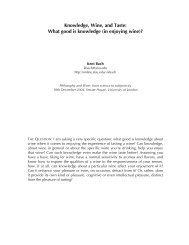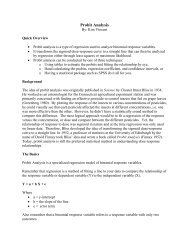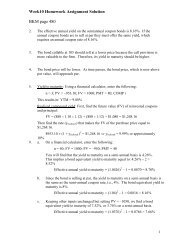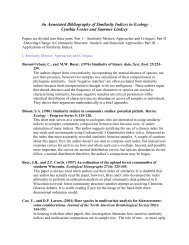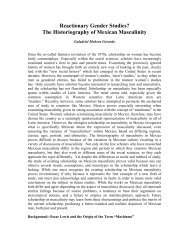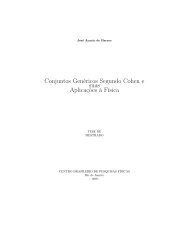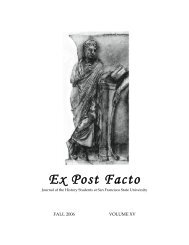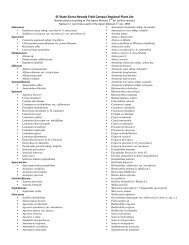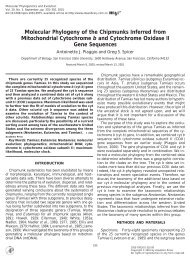Dr. Edward R Tufte - San Francisco State University
Dr. Edward R Tufte - San Francisco State University
Dr. Edward R Tufte - San Francisco State University
Create successful ePaper yourself
Turn your PDF publications into a flip-book with our unique Google optimized e-Paper software.
A before-and-after graphical redesign example<br />
from Envisioning Information, p63.<br />
This Information Design Index Card, number 04 created by Rae<br />
Chu-Colwell, is part of a set of 24 cards created by the students of DAI<br />
523, Information Design 1 during the Fall semester of 2009. This set,<br />
conceived by Instructor Pino Trogu, covers a range of Information Design<br />
topic areas, chosen and researched by each student. DAI 523 is a fourthyear<br />
design course within the Design and Industry Department at <strong>San</strong><br />
<strong>Francisco</strong> <strong>State</strong> <strong>University</strong>. DAI 523 provides students with an introduction<br />
to the field of information design, covering stand-alone and system applications<br />
across print, interactive (digital), and environmental mediums.<br />
04<br />
INFORMATION DESIGN INDEX CARDS<br />
<strong>Dr</strong>. <strong>Edward</strong> R <strong>Tufte</strong><br />
the Leonardo da Vinci of data<br />
Brief Biography<br />
“The Leonardo da Vinci of data,” as the New York Times calls him, <strong>Edward</strong><br />
<strong>Tufte</strong> (pronounced TUFF-tee) has written several books on information design<br />
and using statistics to analyze political issues. He writes, designs, and self-publishes<br />
his books on analytical design, which have received more than 40 awards<br />
for content and design. He is Professor Emeritus at Yale <strong>University</strong>, where he<br />
taught courses in statistical evidence, information design, and interface design.<br />
<strong>Tufte</strong> has successfully drawn the attention of countless people to issues of<br />
information design. <strong>Tufte</strong> presents a devastating critique of the way information<br />
is usually pictured to us. Bad graphics, according to <strong>Tufte</strong>, lie by distortion,<br />
obfuscate by omission and confuse by decoration. We have grown accustomed<br />
to awful information.<br />
A Simple Approach<br />
<strong>Tufte</strong>’s approach is deceptively simple. He teaches by visual example. Next to<br />
a bad example of a graph, he positions a sublimely clear treatment, often using<br />
the same data. Simple and effective.<br />
DAI 523<br />
“There STUDENT is no such thing as<br />
PICTURE<br />
Information Design 1<br />
HERE<br />
Design and Industry Department<br />
information <strong>San</strong> <strong>Francisco</strong> overload,<br />
<strong>State</strong> <strong>University</strong><br />
1600 Holloway Ave,<br />
California 94132, USA<br />
there is only Information bad Design Index design.<br />
Card<br />
No. 04 – October 2009<br />
Printed by _____________<br />
Reduce the clutter.”
<strong>Tufte</strong>’s Top 5 List<br />
1<br />
Data-Ink<br />
<strong>Tufte</strong> uses the term “data-ink ratio” to argue against including non-informative<br />
decoration in visual displays of quantitative information, and says that all ink<br />
not used to convey and display data should be eliminated.<br />
2<br />
Chart Junk<br />
In dismantling some of the worst habits of two-dimensional design, he has<br />
framed a new analytical term, “chart junk,” it includes the ubiquitous,<br />
unneeded words and addenda that crowds the page, from PowerPoint to<br />
project management charts and financial reports. Most of this junk can be<br />
removed without diminishing understanding. “Clutter is a failure of design,<br />
not an attribute of information,” Envisioning Information.<br />
3<br />
Sparklines<br />
<strong>Tufte</strong> innovated “sparklines,” they are intense, simple, word-size Graphics.<br />
“They can be embedded in-line in a sentence, summarizing millions of points of<br />
data in the space of a word,” says <strong>Tufte</strong>.<br />
4The Cognitive Style of PowerPoint<br />
“PowerPoint is evil” – PowerPoint is a competent slide manager and projector.<br />
But rather than supplementing a presentation, it has become a substitute for<br />
it. Such misuse ignores the most important rule of speaking: Respect your<br />
audience.<br />
5<br />
Escaping Flatland<br />
“We envision information in order to reason about, communicate, document, and<br />
preserve that knowledge, activities nearly always carried out on two-dimensional<br />
paper and computer screen. Escaping this flatland and enriching the density of data<br />
displays are the essential tasks of information design.” Envisioning Information.<br />
Must reads by <strong>Tufte</strong>: The Visual Display of Quantitative Information, Envisioning Information, Visual Explanations, and Beautiful Evidence.<br />
Information Design Index Cards is a set of cards designed and produced by the<br />
students of DAI 523, Information Design 1, a fourth-year course in the Design<br />
and Industry Department, <strong>San</strong> <strong>Francisco</strong> <strong>State</strong> <strong>University</strong>, Fall 2009. The set, by<br />
no means complete, is composed of 1+22 cards on Information Design topics.<br />
Coordinated by instructor Pino Trogu, each topic was chosen and researched<br />
by the students. DAI 523 provides students with an introduction to the field<br />
of information design, covering a variety of applications across print, screen<br />
and environmental media. This is card number 04 and it was designed by<br />
Rae Chu-Colwell.<br />
“Don’t ask<br />
how<br />
visualization<br />
techniques<br />
can help<br />
display data.<br />
Ask<br />
how data<br />
can be best<br />
represented.”<br />
sources: Graphics Press LLC www.edwardtufte.com<br />
DAI 523<br />
Information Design I<br />
Design and Industry Department<br />
College of Creative Arts<br />
<strong>San</strong> <strong>Francisco</strong> <strong>State</strong> <strong>University</strong><br />
California, USA – October 2009<br />
Information Design Index Card<br />
No.04<br />
Printed by JASK Digital Printing



